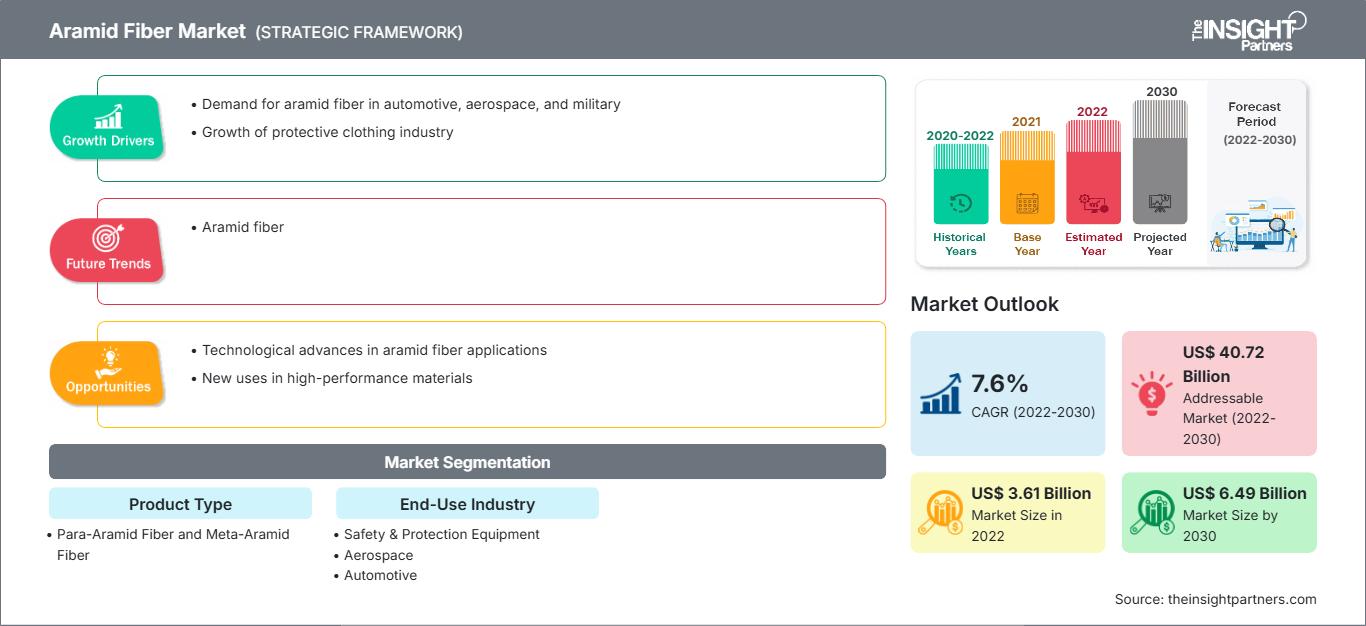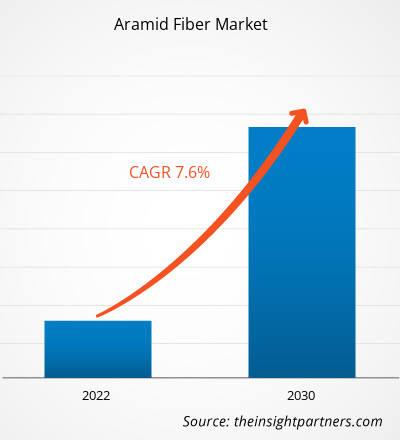[Forschungsbericht] Der Markt für Aramidfasern hatte im Jahr 2022 ein Volumen von 3,61 Milliarden US-Dollar und soll bis 2030 ein Volumen von 6,49 Milliarden US-Dollar erreichen. Von 2022 bis 2030 wird mit einer durchschnittlichen jährlichen Wachstumsrate (CAGR) von 7,6 % gerechnet.
Markteinblicke und Analystenmeinung:
Aramidfasern, auch aromatische Polyamide genannt, sind synthetische Fasern mit außergewöhnlicher Festigkeit, Hitzebeständigkeit und Haltbarkeit. Sie sind bekannt für ihre hohe Zugfestigkeit, die fünf- bis sechsmal höher ist als die von Stahl, und ihr geringes Gewicht von nur einem Fünftel des Gewichts von Stahl. Diese bemerkenswerten Eigenschaften machen diese Fasern für eine Vielzahl von Anwendungen wertvoll, insbesondere in Branchen, in denen hohe Leistung und Sicherheit gefragt sind. Die einzigartige Struktur der Aramidfasern trägt maßgeblich zu ihren außergewöhnlichen Eigenschaften bei. Diese Fasern bestehen aus langen Ketten von Polyamidmolekülen, bei denen die Amidbindungen direkt mit aromatischen Ringen verknüpft sind. Diese Anordnung führt zu einer starren, stabartigen Struktur, die den Fasern eine bemerkenswerte Festigkeit und Steifheit verleiht. Darüber hinaus sorgen die aromatischen Ringe für eine inhärente Hitzebeständigkeit und Stabilität, sodass diese Fasern hohen Temperaturen ohne nennenswerte Qualitätsminderung standhalten können.
Wachstumstreiber und Herausforderungen:
Die steigende Nachfrage aus der Automobilindustrie war eine wichtige Triebkraft hinter der Expansion des Aramidfasermarktes. Die Nachfrage nach diesen Fasern ist exponentiell gestiegen, da die Automobilhersteller sich zunehmend auf die Produktion leichterer und kraftstoffeffizienterer Fahrzeuge konzentrieren. Das hohe Festigkeits-Gewichts-Verhältnis dieser Fasern, insbesondere der Para-Aramid-Varianten wie Kevlar, ermöglicht die Entwicklung von Leichtbauteilen ohne Beeinträchtigung der strukturellen Integrität. Im Automobilsektor werden diese Fasern umfassend in verschiedenen Anwendungen eingesetzt, unter anderem bei der Herstellung von Reifen, Bremsen, Bremsbelägen und Verbundwerkstoffen. Die Verstärkung dieser Komponenten mit diesen Fasern erhöht ihre Haltbarkeit und Verschleißfestigkeit und trägt so zu einer längeren Lebensdauer und verbesserten Gesamtleistung bei. Darüber hinaus werden diese Fasern bei der Herstellung von Automobilverbundwerkstoffen eingesetzt und sorgen für ein ausgewogenes Verhältnis zwischen Festigkeit und Gewicht, das für die Erreichung der Kraftstoffeffizienzziele entscheidend ist. All diese Faktoren treiben die Nachfrage nach Aramidfasern im Automobilsektor.
Der Markt für Aramidfasern ist jedoch aufgrund der Verfügbarkeit von Ersatzstoffen mit ähnlichen oder alternativen Eigenschaften wachstumsbegrenzt. Kohlefaser ist einer der wichtigsten Ersatzstoffe für diese Fasern und teilt einige Eigenschaften mit Aramidfasern, darunter hohe Festigkeit und geringes Gewicht. In bestimmten Anwendungen entscheiden sich Hersteller möglicherweise für Kohlefaser als Alternative, insbesondere wenn sie Materialien mit höherer Steifigkeit oder Leitfähigkeit suchen. Diese Konkurrenz durch Ersatzstoffe erschwert die flächendeckende Einführung dieser Fasern, insbesondere in Branchen, in denen beide Materialien potenziell die erforderlichen Spezifikationen erfüllen könnten.
Passen Sie diesen Bericht Ihren Anforderungen an
Sie erhalten kostenlos Anpassungen an jedem Bericht, einschließlich Teilen dieses Berichts oder einer Analyse auf Länderebene, eines Excel-Datenpakets sowie tolle Angebote und Rabatte für Start-ups und Universitäten.
Aramidfasermarkt: Strategische Einblicke

-
Holen Sie sich die wichtigsten Markttrends aus diesem Bericht.Dieses KOSTENLOSE Beispiel umfasst Datenanalysen, die von Markttrends bis hin zu Schätzungen und Prognosen reichen.
Berichtssegmentierung und -umfang:
Die „Globale Marktanalyse für Aramidfasern bis 2030“ ist eine spezialisierte und detaillierte Studie mit Schwerpunkt auf Markttrends und Wachstumschancen weltweit. Der Bericht bietet einen Überblick über den Markt mit detaillierter Marktsegmentierung nach Produkttyp und Endverbrauchsbranche. Der Markt verzeichnete in der jüngeren Vergangenheit ein starkes Wachstum und dürfte diesen Trend im Prognosezeitraum fortsetzen. Der Bericht liefert wichtige Statistiken zum weltweiten Verbrauch von Aramidfasern. Darüber hinaus bietet der Bericht eine qualitative Bewertung verschiedener Faktoren, die die globale Marktentwicklung für Aramidfasern beeinflussen. Der Bericht enthält außerdem eine umfassende Analyse der führenden Marktteilnehmer und ihrer wichtigsten strategischen Entwicklungen. Es sind auch mehrere Analysen der Marktdynamik enthalten, um die wichtigsten Antriebsfaktoren, Markttrends und lukrativen Gelegenheiten zu identifizieren, die wiederum bei der Identifizierung der wichtigsten Einnahmequellen helfen.
Die Ökosystemanalyse und die Fünf-Kräfte-Analyse von Porter bieten eine 360-Grad-Ansicht des Marktes, die hilft, die gesamte Lieferkette und die verschiedenen Faktoren zu verstehen, die das Wachstum des globalen Aramidfasermarktes beeinflussen.
Segmentanalyse:
Auf der Grundlage des Produkttyps ist der Markt in Para-Aramidfaser und Meta-Aramidfaser unterteilt. In Bezug auf die Endverbrauchsindustrie ist der Markt in Sicherheits- und Schutzausrüstung, Luft- und Raumfahrt, Automobil, Elektronik und Telekommunikation und andere segmentiert. Die Sicherheits- und Das Segment Schutzausrüstung verzeichnete 2022 einen bedeutenden Marktanteil bei Aramidfasern. Aramidfasern, insbesondere Para-Aramid-Varianten wie Kevlar, sind für ihre außergewöhnliche Festigkeit, ihren hohen Elastizitätsmodul und ihre Schlagfestigkeit bekannt und eignen sich daher ideal für Anwendungen, bei denen Sicherheit und Schutz an erster Stelle stehen. Diese Faser wird häufig bei der Herstellung von ballistischen Westen und Helmen verwendet. Die inhärente ballistische Widerstandsfähigkeit dieser Fasern, gepaart mit ihrem geringen Gewicht, macht sie zu einer bevorzugten Wahl für Körperpanzerungen. Militär- und Strafverfolgungsbehörden weltweit verwenden häufig Schutzausrüstung auf Aramidbasis, um Personal wirksam vor ballistischen Bedrohungen zu schützen, ohne die Mobilität einzuschränken. All diese Faktoren treiben den Aramidfasermarkt für das Segment Sicherheits- und Schutzausrüstung an.
Regionale Analyse:
Geografisch ist der Aramidfasermarkt in fünf Schlüsselregionen unterteilt: Nordamerika, Europa, Asien-Pazifik, Süd- und Mittelamerika sowie Naher Osten und Afrika. Der Markt wurde vom asiatisch-pazifischen Raum dominiert, der im Jahr 2022 etwa 1 Milliarde US-Dollar ausmachte. Die Region bietet zahlreiche Möglichkeiten für das Wachstum des Marktes. Steigende ausländische Direktinvestitionen führen ebenfalls zu Wirtschaftswachstum in der Region. Die zunehmende Verwendung dieser Fasern in zahlreichen Anwendungen, darunter Autoteile, Elektronik und andere, dürfte die Nachfrage nach Aramidfasern im asiatisch-pazifischen Raum erhöhen.
Für Europa wird von 2022 bis 2030 eine durchschnittliche jährliche Wachstumsrate (CAGR) von über 8,0 % erwartet. Aramidfasern sind entscheidend für die Herstellung leichter und dennoch robuster Komponenten in Flugzeugstrukturen und ballistischen Schutzsystemen. Da Europa führende Luft- und Raumfahrtunternehmen und einen bedeutenden Verteidigungssektor beherbergt, steigt die Nachfrage nach Aramidfasern in diesen Branchen weiter an. Darüber hinaus wird erwartet, dass Nordamerika im Jahr 2030 rund 1,7 Milliarden US-Dollar erreichen wird.
Branchenentwicklungen und zukünftige Chancen:
Verschiedene Initiativen der wichtigsten Akteure auf dem Aramidfasermarkt sind unten aufgeführt:
- Im April 2023 kündigte DuPont de Nemours Inc. die Einführung der Aramidfaser Kevlar EXOTM an. Kevlar EXO bietet eine Kombination aus Leichtigkeit, Flexibilität und Schutz durch Aramidfaser, wobei der Lebensschutz der erste von vielen Anwendungsfällen ist.
Aramidfaser
Regionale Einblicke in den AramidfasermarktDie Analysten von The Insight Partners haben die regionalen Trends und Faktoren, die den Aramidfasermarkt im Prognosezeitraum beeinflussen, ausführlich erläutert. In diesem Abschnitt werden auch die Marktsegmente und die geografische Lage in Nordamerika, Europa, dem asiatisch-pazifischen Raum, dem Nahen Osten und Afrika sowie Süd- und Mittelamerika erörtert.
Umfang des Aramidfaser-Marktberichts
| Berichtsattribut | Einzelheiten |
|---|---|
| Marktgröße in 2022 | US$ 3.61 Billion |
| Marktgröße nach 2030 | US$ 6.49 Billion |
| Globale CAGR (2022 - 2030) | 7.6% |
| Historische Daten | 2020-2022 |
| Prognosezeitraum | 2022-2030 |
| Abgedeckte Segmente |
By Produkttyp
|
| Abgedeckte Regionen und Länder |
Nordamerika
|
| Marktführer und wichtige Unternehmensprofile |
|
Dichte der Marktteilnehmer für Aramidfasern: Verständnis ihrer Auswirkungen auf die Geschäftsdynamik
Der Aramidfasermarkt wächst rasant, angetrieben durch die steigende Endverbrauchernachfrage aufgrund von Faktoren wie sich entwickelnden Verbraucherpräferenzen, technologischem Fortschritt und einem stärkeren Bewusstsein für die Produktvorteile. Mit steigender Nachfrage erweitern Unternehmen ihr Angebot, entwickeln Innovationen, um den Verbraucherbedürfnissen gerecht zu werden, und nutzen neue Trends, was das Marktwachstum weiter ankurbelt.

- Holen Sie sich die Aramidfasermarkt Übersicht der wichtigsten Akteure
Auswirkungen von COVID-19:
Die COVID-19-Pandemie hatte negative Auswirkungen auf fast alle Branchen in verschiedenen Ländern. Lockdowns, Reisebeschränkungen und Betriebsschließungen in Nordamerika, Europa, im asiatisch-pazifischen Raum (APAC), Süd- und Mittelamerika sowie im Nahen Osten und Afrika (MEA) bremsten das Wachstum mehrerer Branchen, darunter der Chemie- und Werkstoffindustrie. Die Schließung von Produktionsstätten von Aramidfaserunternehmen störte globale Lieferketten, Fertigungsaktivitäten und Lieferpläne. Verschiedene Unternehmen meldeten Verzögerungen bei Produktlieferungen und einen Einbruch ihrer Produktverkäufe im Jahr 2020. Die meisten industriellen Produktionsanlagen wurden während der Pandemie geschlossen, was den Verbrauch dieser Fasern verringerte. Darüber hinaus hat die COVID-19-Pandemie Schwankungen bei den Aramidfaserpreisen verursacht. Verschiedene Branchen nahmen jedoch ihren Betrieb wieder auf, nachdem die Lieferengpässe gelöst waren, was zu einer Wiederbelebung des Marktes für Kunststoffbehälter führte. Darüber hinaus fördert die steigende Nachfrage nach diesen Fasern aus der Automobilindustrie das Wachstum des Aramidfasermarktes erheblich.
Wettbewerbslandschaft und Schlüsselunternehmen:
DuPont de Nemours Inc, Teijin Limited, Yantai Tayho Advanced Materials Company, Hyosung Corporation, Toray Industries Inc, Kolon Industries, Huvis Corporation, China National Bluestar (Group) Co Ltd, Taekwang Industrial Co Ltd und Kermel SAS gehören zu den wichtigsten Akteuren auf dem globalen Aramidfasermarkt. Die globalen Marktteilnehmer konzentrieren sich auf die Bereitstellung qualitativ hochwertiger Produkte, um die Kundennachfrage zu erfüllen.
- Historische Analyse (2 Jahre), Basisjahr, Prognose (7 Jahre) mit CAGR
- PEST- und SWOT-Analyse
- Marktgröße Wert/Volumen – Global, Regional, Land
- Branchen- und Wettbewerbslandschaft
- Excel-Datensatz
Aktuelle Berichte
Verwandte Berichte
Erfahrungsberichte
Grund zum Kauf
- Fundierte Entscheidungsfindung
- Marktdynamik verstehen
- Wettbewerbsanalyse
- Kundeneinblicke
- Marktprognosen
- Risikominimierung
- Strategische Planung
- Investitionsbegründung
- Identifizierung neuer Märkte
- Verbesserung von Marketingstrategien
- Steigerung der Betriebseffizienz
- Anpassung an regulatorische Trends






















 Kostenlose Probe anfordern für - Aramidfasermarkt
Kostenlose Probe anfordern für - Aramidfasermarkt